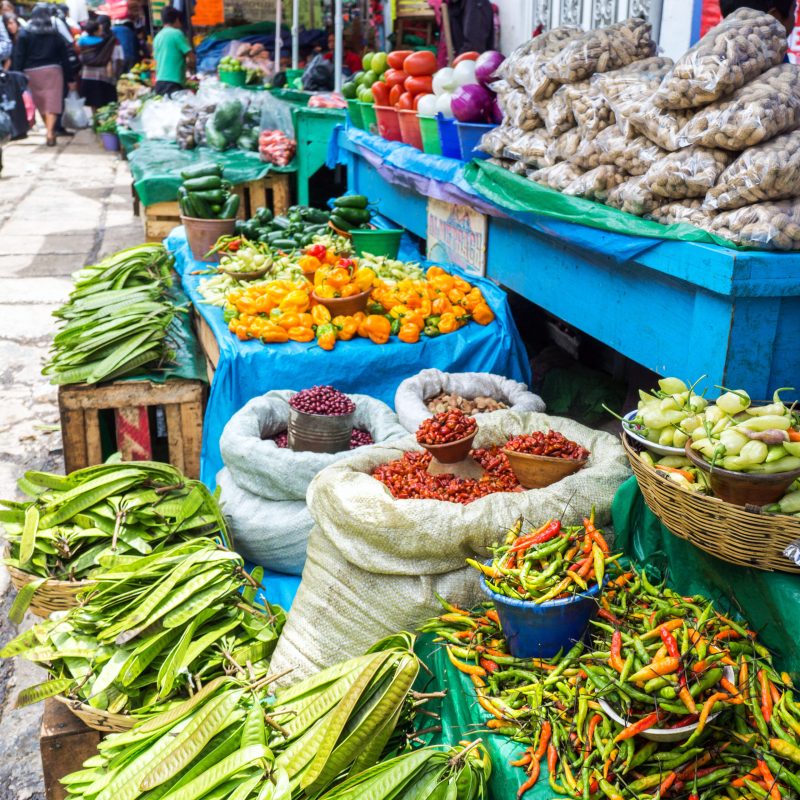
The first time I visited a Mexican market, or mercado, I thought I’d stumbled into some sort of carnival. Street vendors sold a variety of delicious-looking foods (on further examination, they were, in fact, delicious) while shop vendors peddled an incredible variety of goods. For a few hundred pesos, a person could walk away with a full stomach, groceries, a cool souvenir, and a puppy. Seriously, people were selling puppies.
Videos by TravelAwaits
If you’re looking for a quick way to dive into Mexican culture, a visit to a mercado should be at the top of your list. Here are a few things I learned on my trips — and a few mistakes that tourists should avoid.
1. You’ll Find Markets In Most Mexican Cities
Mercados are a part of Mexican culture, and regardless of where you’re traveling, you’ll find them fairly easily. In Mexico City, some of the most popular options include the iconic Coyoacan Market, Milan 44, and La Lagunilla.
However, markets vary substantially in terms of size and offerings, so if you’re looking for something specific, you’ll need to do some research. Milan 44, for instance, is a fairly upscale market with luxury goods; Coyoacan Market is a great place to get high-quality local fare, while La Langunilla is the go-to spot for antiques.
You can research major markets online, but in smaller towns, you’ll have to ask the locals. A quick Donde esta el mercado? should get you headed in the right direction.
2. Most Mexican Markets Are Crowded, So Be Prepared
Be ready for heavy foot traffic, and prepare to say perdon (“sorry” or “pardon me”) a lot as you bump into busy shoppers. My Spanish is terrible, but I was thankful I brushed up on basic niceties before heading to a mercado.
Expect narrow aisles and lots of walking. Crime is rare at most mercados, but don’t show obvious signs of wealth (for instance, expensive watches or jewelry), and keep your phone in your pocket unless you absolutely need to use it. Pickpockets do exist in places like Mexico City, so use common sense and be aware of your surroundings.
Typically, a Mexican market will have an indoor area and an outdoor area; indoor areas are rarely air-conditioned, but they provide some relief from the heat during the hotter months of the year. Since you’ll be spending quite a bit of time on your feet, you might want to bring a bottle of water or pick one up from a vendor. This should go without saying, but unless you’ve taken precautionary antibiotics, you shouldn’t drink the tap water.
3. Bartering Is Normal (And Somewhat Necessary)
I’m not much of a barterer, but in Mexico, bartering is necessary in some situations. On my last day in the country, I wanted to buy a small guitar for my host’s son. Its listed price was around 1,350 pesos (roughly $70). I had about 1,200 pesos in my wallet, and I knew that the store owner would accept less, so I simply asked him in (terrible) Spanish whether he could manage 1,200.
He looked at me like I was crazy, and then agreed. The lower price was still too much for the instrument — I learned later that he expected to get around 1,000 for it.
Granted, tourists can get around Mexico without bartering, but if you’re making any significant purchase, asking for a lower price isn’t considered rude. The process is fairly simple: Ask the price, and then shake your head and look disappointed. If the vendor doesn’t respond, start to walk away. You don’t really need to speak much Spanish, since the shop owner will likely offer a lower price immediately.
Of course, you can’t get the really good deals without brushing up on your communication skills, but basic bartering can be fun (and thrifty). Just know when to stop pressing the vendors, and don’t try to barter at larger stores or resort shops. A good rule of thumb: If the shop has signs about VAT purchases, don’t start bartering. Speaking of which…
4. For Large Purchases At Large Stores, Keep VAT In Mind
If you’re paying with a card and you’re shopping at a larger store — for instance, one of the markets you’ll find near major resorts in Cancun — keep your value-added tax (VAT) receipts. You may be able to get a refund when you leave the country, provided that you paid at least 1,200 pesos per receipt.
The VAT refund only applies to goods, not services, and it’s only applicable to participating stores (so don’t count on getting a refund from markets in smaller cities). While we’re on the subject, don’t expect smaller shops to take your credit card. Carry plenty of pesos and be ready to count them out quickly.

5. Don’t Trust The Brand Names
I’ve got a great pair of Ray-Ban sunglasses that I purchased at a Mexican market, but they’re made of cheap plastic, and the Ray-Ban insignia is slightly askew. At the same market, I saw dozens of other luxury products at rock-bottom prices, and though some of them looked fairly convincing, I’d bet dollars to pesos that they were counterfeit (and yes, this is one of the few instances where I can use that phrase legitimately).
In most markets, counterfeits are everywhere, but higher-end mercados like Milan 44 have legitimate deals on name brands. Trust your instincts: If a deal seems too good to be true, that’s probably the case.
When picking out handcrafted goods, check for manufacturing tags. There’s nothing worse than buying an “authentic” Mexican trinket that was actually made in China, and while that’s not a huge concern at most markets, a careful approach will help you avoid an embarrassing mistake.
6. Be Sure To Try The Street Food
If you’re squeamish about street food, you might want to get over it — mercados have an incredible variety of excellent comfort foods, from filling classics like empanadas and tortas to soups like menudo and pozole. To be respectful, you should find a table or stand to the side while eating.
Tourists are often concerned about the safety of street foods, and while I had no reservations about chowing down on a plate of elote (Mexican street corn), I understand the concern.
If you find the made-to-order options unappetizing or if you’re worried about food sickness, look for stalls selling packaged candies and pick up some Vero Rebanaditas (watermelon lollipops with chili at the center) or mazapan (peanut candy). These confections make great gifts for friends, provided that you don’t scarf them all down before your trip back home.
7. Browse The Entire Market Before Buying Anything
As you walk the aisles, you’ll be tempted to pull out your pesos, but try to browse the entire market before making any purchasing decisions. Many vendors sell the same types of items, and you might find something at a better price.
Besides, by walking around for a bit, you’ll get a sense of how the mercado operates, and you can backtrack quite easily even in the more crowded areas. Mexicans are rarely in a hurry when they’re shopping — take a cue from them and take your time.
8. Be Respectful When Taking Photos
You’ll want to snap a few pictures while walking through the crowded, narrow aisles of an authentic mercado, and by all means, go for it — just avoid taking photos of shoppers or shopkeepers. As is the case in the United States (or, really, anywhere in the world), it’s considered rude to photograph someone without their consent. Abide by No Photos (or No Fotos) signs, which are common in tourist-heavy areas.
Likewise, you shouldn’t stand in place for too long, especially if you’re blocking part of a storefront display. While you’re on vacation, the shopkeepers are trying to earn a living, and they depend on a steady flow of traffic to make sales.
Even if you don’t make a purchase, your trip to a mercado will give you a better idea of Mexican life, and they’re a great cultural experience to include on any trip. I was fortunate to have the company of a few locals, which made the visit more enjoyable, but you can handle a mercado on your own — just do your research, be respectful, and use common sense.
Planning a trip to Mexico? Be sure to follow these safety tips.

